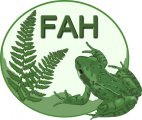
Friends of Angus Herpetofauna (FAH)
About us
About Us
Friends of Angus Herpetofauna (FAH) is a local Amphibian & Reptile Group (ARG) founded in 2007, serving Angus and surrounding areas. Affiliated to ARG-UK, the national umbrella group for local ARGs, FAH is a constituted, non-profit group of volunteers, involved particularly in various monitoring projects at a local level linking into schemes of national importance.
At present, FAH is conducting annual surveys throughout the county to monitor the presence and status of our widespread amphibian and reptile species. These surveys feed directly to the National Amphibian and Reptile Recording Scheme (NARRS) coordinated by the Amphibian & Reptile Conservation Trust (ARC Trust). Survey protocols are strictly controlled and training of voluntary surveyors is provided free at the beginning of each survey season.
Projects currently in progress include a study into the effectiveness of amphibian ladders in gulleypots (roadside drains). Migrating amphibians frequently fall into gulleypots and remain entrapped, unable to escape, eventually dying a lingering death. New ladders, designed by FAH (based on an idea from RAVON) are proving to be a viable sollution to this long-standing problem and are now installed in pioneering work in three locations across the county. FAH are also keen to identify amphibian migration crossing points and set up Toad Patrols, which involves the recruitment of volunteers to collect amphibians with torches and buckets to help them across busy roads where they might otherwise be killed by passing road traffic.
FAH can offer pond and habitat surveys on request either to an established protocol or to a tailored specification. FAH also provide the manpower to undertake a range of field work, including monitoring and habitat management, or offer help and advice as required. Experienced herpetologists are also on hand to provide training, presentations and guided field walks.
News
News
Ladders proving to be a great success with new material
Our on-going amphibian escape ladder trials are showing that the new Enkamat material is, as expected, providing trapped frogs and toads with much more opportunity to ascend and make their bid for freedom after falling into gullypots during migration.
In the first trial at Silver Birch Drive, Dundee last year, we used hessian as the climbing material as the Enkamat was proving difficult to source. Even with the inferior material, there was a 73% escape success rate (currently unpublished data, to be released soon). Female toads in particular seemed to have trouble ascending the hessian. This year however, we are repeating the study with Enkamat, a randomly woven nylon matting with a 25 year life, which provides much better purchase and should improve the climbing capabilities of the amphibians.
It has been a slow start to the season as we have had a long spell of cold nights, however this week amphibians have been on the move in our area and we are now recording frogs and toads using the ladders to escape from gullypots. Already we have seen many animals in various stages of ascent, and frequently more than one individual on the ladders at the same time. Check out our gallery for the latest pictures, and follow the link below for a YouTube video at our new and second trial site, Orchandbank, Forfar.
https://www.youtube.com/watch?v=MQjmUOSAddo
We still need a student volunteer to monitor the study area at Forfar, so please do get in touch if this is something that interests you.
To find out more about our ladder trials, or to get help setting up a study in your area, please do get in touch via the Contact Us tab.
FAH Recruiting Students for on-going Ladder Trials
FAH has been conducting studies into the use of ladders as an escape mechanism in gulleypots. The study began in 2014 and will continue with alternative materials in 2015. The project(s) involve visiting the study site(s) to observe and record any trapped amphibians and, by comparing results to "control" gulleypots (those without ladders), determining the effectiveness of the escape mechanism. Results will be compiled and reported in the form of a paper or dissertation at the end of the project.
FAH is currently seeking 2 to 4 students to carry out the survey/observation/data gathering and report writing on the projects. There are two study sites; Silver Birch Drive in Dundee and Orchardbank in Forfar. Students may work alone or in pairs at each site. Sites will need to be visited daily or every two days, for around 1 - 2 hours. Students living nearby to the study sites will find this advantageous, or will require their own transport.
These studies would suit students with an interest in wildlife and conservation, although many other aspects could be applied (for example, the student in 2014 applied the results of the study to a statistics module). No specific qualifications are required as all training and guidance will be given, as will necessary equipment and PPE. The work can be physical (lifting heavy gulleypot covers occasionally). Study sites can be visited at any time of day, but evening visits are advantageous for observing amphibian movements, especially early in the Spring. The study will begin in March and continue until September.
Participation will be voluntary; students should note that there may be grants available to cover travel costs, etc, and FAH will support any such grant applications by reference.
If you are a student looking to participate in a project to feed into your studies, please contact Trevor Rose at FAH by emailing secretary@thebhs.org of baankulab@yahoo.co.uk
FAH to trial gulleypot ladders in Angus
Gulleypots (roadside drains) have long been a problem for amphibians and other small animals as they act as pitfall traps from which entrapped animals have no means of escape.
FAH have now secured permissions from Angus Council to install and trial specially designed “ladders” at two sites known to be a particular problem. 25 ladders were installed yesterday (5th March 2014) at a site to the north of Dundee and a further 12 at a problem area in Carnoustie.
The Dundee site will be the subject of an intensive study being carried out by honours degree student Clare McInroy. In addition to the 25 gulleypots with the ladders installed, a further 13 gulleypots will act as “controls”, to monitor and compare the effectiveness of the ladders. During installation of the ladders on both sites, 20 frogs, 33 toads and 6 newts were found to be present and were released at breeding ponds nearby.
The ladder design is based on extensive work carried out recently in The Netherlands by the conservation organisation, RAVON. A presentation by Mr. Raymond Creemers at the annual Herp Worker’s Meeting held in Bristol earlier this year prompted FAH into action and the RAVON design was adapted to suit local conditions in Angus.
The ladders are made of steel sheet, cut to length to suit each gulleypot and then bent to form a gradually-reducing incline which levels out underneath the gulleypot cover. The steel is then covered in jute, a material which will provide frogs, toads and newts with a climbing frame and allow them to reach the underside of the drain cover, and then hop through the grating to freedom.
Hundreds of thousands of amphibians die a slow, lingering death in gulleypots every year in the UK. It is hoped, if the ladders are proved to be a successful solution, that they could be fitted to gulleypots everywhere and provide amphibians with a fighting chance of escape and help to halt the decline in their ever-falling numbers.
Tayside Launches new ARG
Our neighbours in Tayside will be launching their new Amphibian and Reptile group on 31st August 2013 in Blairgowrie - details below!Please give this event your support by coming along and meeting the new group.
Tayside Amphibian & Reptile Group (TayARG) meeting
9.30am-3pm, Sat 31st August
Newhill Primary School, Elm Drive, Blairgowrie, PH10 6UZ
Programme:
9.30am Arrival and refreshments
10am Pete Minting (ARC Scotland) - Amphibian & Reptile volunteering in Scotland
10.30am Daniele Muir (Perth & Kinross Ranger Service/TayARG) - Amphibians in Drains Project
11am Catherine Lloyd (Tayside Biodiversity Partnership/TayARG) — Water & Wetland projects in Tayside
11.25am Break
11.45am Gullypot rescue ID
12pm General discussion—the way forward for TayARG
12.30pm Lunch (please bring packed lunch)
Please reserve your place by contacting taysideamphibians@yahoo.co.uk by 17th August
FAH Summary Report - 2012
NARRS training was rolled out once again and as always was very popular, with 13 attendees on the amphibian day and 14 on the reptile day. It is pleasing to see that biological recording is gaining momentum and so many new surveyors for reptiles and amphibians are joining up to the NARRS scheme. Thanks especially to Mr. Harold Jackson for the continuing use of his pond in the amphibian training.
We also held our annual guided walks to Loch Lee in Glen Esk in search of reptiles and amphibians, a now regular feature on the group’s calendar. The walks were fully booked as usual, but unfortunately both dates were marred by inclement weather, with just a few specimens found on the first trip and, for the first time ever, a complete blank on the second visit. Even our refugia turned up nothing! Attendees were understanding though and still claimed to have enjoyed the day. The fresh air and superb scenery never fail to delight.
Ongoing monitoring of the Kinnaber site, where in 2011 the group were involved in a last-minute “rescue bid” to save common lizards from construction of a cycle path, revealed that lizards were prevailing at the site and apparently doing well. The mixed bag of weather this summer has hampered any meaningful monitoring though so we look forward to further studies over the next few years.
The high profile of the Kinnaber project has befitted reptile and amphibian conservation locally, as FAH have been approached by developers and planners on other projects, thankfully allowing more timely intervention where it is required. Not least is a development currently at the planning stage in the reptile=rich area of Glen Esk, where slowworms are a particular concern.
FAH are very grateful to ARG-UK for the free website launched in 2010, and now again for the superb new website recording system. We look forward to seeing records building up for Angus over time, especially with so many local NARRS participants! It will be interesting to build a better picture of reptile and amphibian distribution across the county, which currently remains anecdotal at best, due to the lack of recent records.
We had hope to officially launch the FAH with a pond-building project in 2012, sadly this did not materialise but still remains on the Agenda for 2013. FAH will also be running NARRS training in neighboring Aberdeenshire in March 2013, date to be finalised so please keep checking our website!
Photo gallery
Photo Gallery
Contact us
Contact Us
c/o 11 Strathmore Place
Montrose
Angus
DD10 8 LQ
Upcoming Events
Upcoming events will be listed here.
Latest News
- Angus Amphibian Ladders Going Global!
31/01/2020 12:40 pm - Exciting new Smooth Newt record for Angus
04/04/2018 12:16 pm - Giant reptile washed up on local beach
15/01/2016 9:02 am - Amphibian Ladder Trial Study Results now Published
13/08/2015 8:44 am - Launch of the Amphibians in Ladders Report & Angus Council Biodiversity Duty Report
20/05/2015 1:02 pm
© Friends of Angus Herpetofauna (FAH)
Website hits: 36949
View All | Find out how to get a mini-website for your ARG
© ARG UK Local Groups mini-websites 2024
Wind powered websites by Aye-aye Design.
